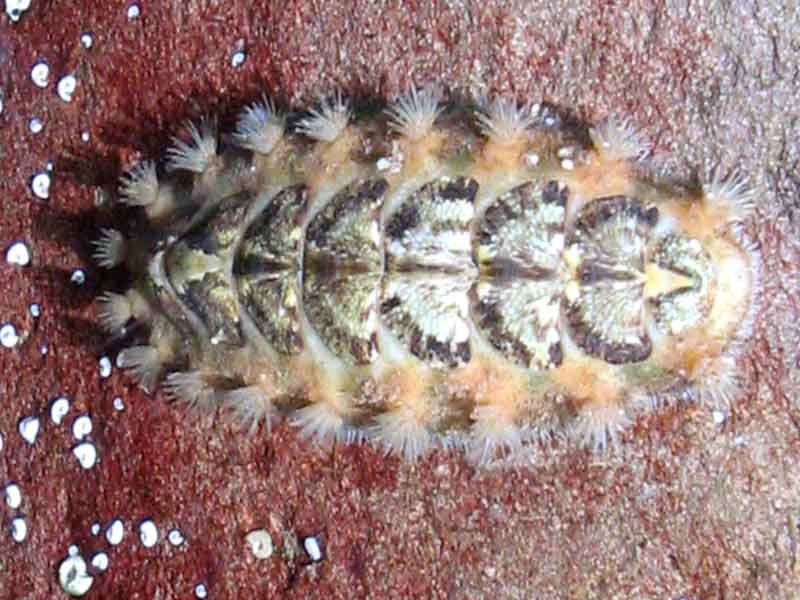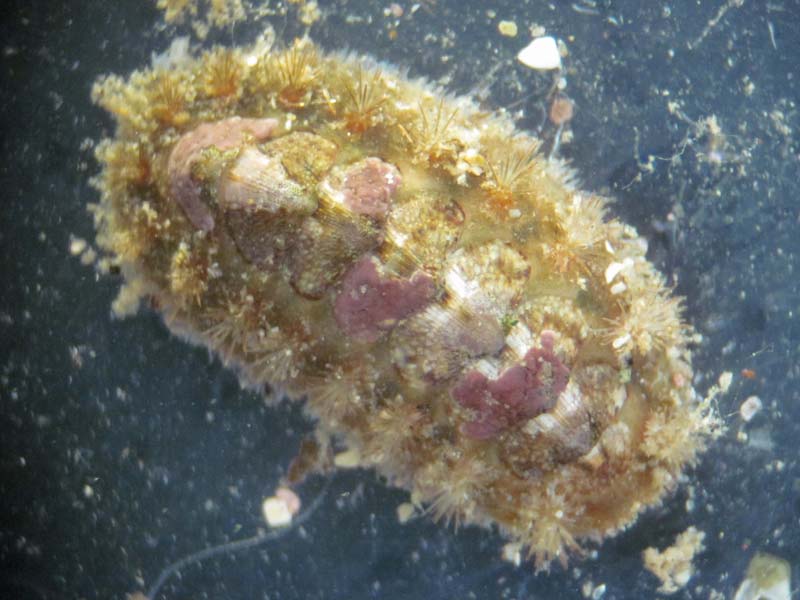Bristly mail shell (Acanthochitona crinita)
Distribution data supplied by the Ocean Biodiversity Information System (OBIS). To interrogate UK data visit the NBN Atlas.Map Help
| Researched by | Sonia Rowley | Refereed by | This information is not refereed |
| Authority | (Pennant, 1777) | ||
| Other common names | Bristly mail chiton | Synonyms | - |
Summary
Description
Acanthochitona crinita is an oval-shaped chiton with a flattened elongate body up to 3.4 cm long. The body is protected by a shell composed of eight interlocked transverse, coarsely keeled plates or valves. These can vary in colouration and combination from off-white, yellowish-brown, olive-green, pinkish or marbled. This species has a white V-shaped area in the centre of the valves. The shell valves possess notches, with five typically on the anterior margin of the head valve. The intermediate valves are short and wing-like, whereas the tail valve is small and oval. Each of the shell valves is covered with irregularly distributed tubercles of various sizes. The broad girdle is fringed with 18-20 dense tufts of colourless bristles, four surrounding the head valve and two at each valve intersection. There are short spines and randomly distributed curved spines that also cover the remainder of the girdle. In the posterior region of the mantle groove, there are 10-15 pairs of gills.
Recorded distribution in Britain and Ireland
This species has been recorded from the west and south-west coasts of Britain and Ireland. Probably under-recorded.Global distribution
Recorded from the British Isles and north coast of France with a few scattered records in the North Sea towards the south coast of Norway. Some records on the south and north-west Italian coast as well as around Palma. One record from the southern coasts of Morocco and another from Greece.Habitat
Acanthochitona crinita can be found firmly attached to the underside of rocks on the lower shore and sublittoral down to 70 m in depth.Depth range
Lower shore to 70 mIdentifying features
- Flattened, elongated oval body up to 3.4 cm long.
- Colour variable; off-white, yellowish-brown, olive-green, pinkish, or marbled.
- Eight shell valves covered in irregular tubercles.
- A white V-shaped area in the centre of the valves.
- Girdle fringed with 18-20 tufts of bristles.
Additional information
'Coat-of-mail' shells get their name from the armoured appearance of the valves like links in chain mail. These eight valves allow Acanthochitona crinita to bend and tightly cling onto uneven rock surfaces. When dislodged, they roll up like woodlice.
Listed by
- none -
Bibliography
Baxter. J. & Light. J., 1990. Some unusual specimens of Acanthochitona crinita from off the Isle of Wight, Weymouth and Anglesey. Journal of Conchology, 33, 335-340.
Bruce, J.R., Colman, J.S. & Jones, N.S., 1963. Marine fauna of the Isle of Man. Liverpool: Liverpool University Press.
Dipper, R., & Powell. A., 1984. Field guide to the water life of Britain. London: Reader's Digest Association Limited.
Gibson, R., Hextall, B. & Rogers, A., 2001. Photographic guide to the sea and seashore life of Britain and north-west Europe. Oxford: Oxford University Press.
Hayward, P., Nelson-Smith, T. & Shields, C. 1996. Collins pocket guide. Sea shore of Britain and northern Europe. London: HarperCollins.
Hayward, P.J. & Ryland, J.S. (ed.) 1995b. Handbook of the marine fauna of North-West Europe. Oxford: Oxford University Press.
Jones, A.M. & Baxter, J.M., 1987b. Molluscs: Caudofoveata, Solenogastres, Polyplacophora and Scaphopoda. Avon: The Bath Press. [Synopses of the British Fauna No. 37.]
Datasets
Centre for Environmental Data and Recording, 2018. IBIS Project Data. Occurrence dataset: https://www.nmni.com/CEDaR/CEDaR-Centre-for-Environmental-Data-and-Recording.aspx accessed via NBNAtlas.org on 2018-09-25.
Centre for Environmental Data and Recording, 2018. Ulster Museum Marine Surveys of Northern Ireland Coastal Waters. Occurrence dataset https://www.nmni.com/CEDaR/CEDaR-Centre-for-Environmental-Data-and-Recording.aspx accessed via NBNAtlas.org on 2018-09-25.
Conchological Society of Great Britain & Ireland, 2018. Mollusc (marine) data for Great Britain and Ireland - restricted access. Occurrence dataset: https://doi.org/10.15468/4bsawx accessed via GBIF.org on 2018-09-25.
Conchological Society of Great Britain & Ireland, 2023. Mollusc (marine) records for Great Britain and Ireland. Occurrence dataset: https://doi.org/10.15468/aurwcz accessed via GBIF.org on 2024-09-27.
Environmental Records Information Centre North East, 2018. ERIC NE Combined dataset to 2017. Occurrence dataset: http://www.ericnortheast.org.ukl accessed via NBNAtlas.org on 2018-09-38
Fenwick, 2018. Aphotomarine. Occurrence dataset http://www.aphotomarine.com/index.html Accessed via NBNAtlas.org on 2018-10-01
Kent Wildlife Trust, 2018. Kent Wildlife Trust Shoresearch Intertidal Survey 2004 onwards. Occurrence dataset: https://www.kentwildlifetrust.org.uk/ accessed via NBNAtlas.org on 2018-10-01.
Manx Biological Recording Partnership, 2017. Isle of Man wildlife records from 01/01/2000 to 13/02/2017. Occurrence dataset: https://doi.org/10.15468/mopwow accessed via GBIF.org on 2018-10-01.
National Trust, 2017. National Trust Species Records. Occurrence dataset: https://doi.org/10.15468/opc6g1 accessed via GBIF.org on 2018-10-01.
NBN (National Biodiversity Network) Atlas. Available from: https://www.nbnatlas.org.
OBIS (Ocean Biodiversity Information System), 2025. Global map of species distribution using gridded data. Available from: Ocean Biogeographic Information System. www.iobis.org. Accessed: 2025-07-01
South East Wales Biodiversity Records Centre, 2018. SEWBReC Molluscs (South East Wales). Occurrence dataset: https://doi.org/10.15468/jos5ga accessed via GBIF.org on 2018-10-02.
Yorkshire Wildlife Trust, 2018. Yorkshire Wildlife Trust Shoresearch. Occurrence dataset: https://doi.org/10.15468/1nw3ch accessed via GBIF.org on 2018-10-02.
Citation
This review can be cited as:
Last Updated: 22/07/2005




